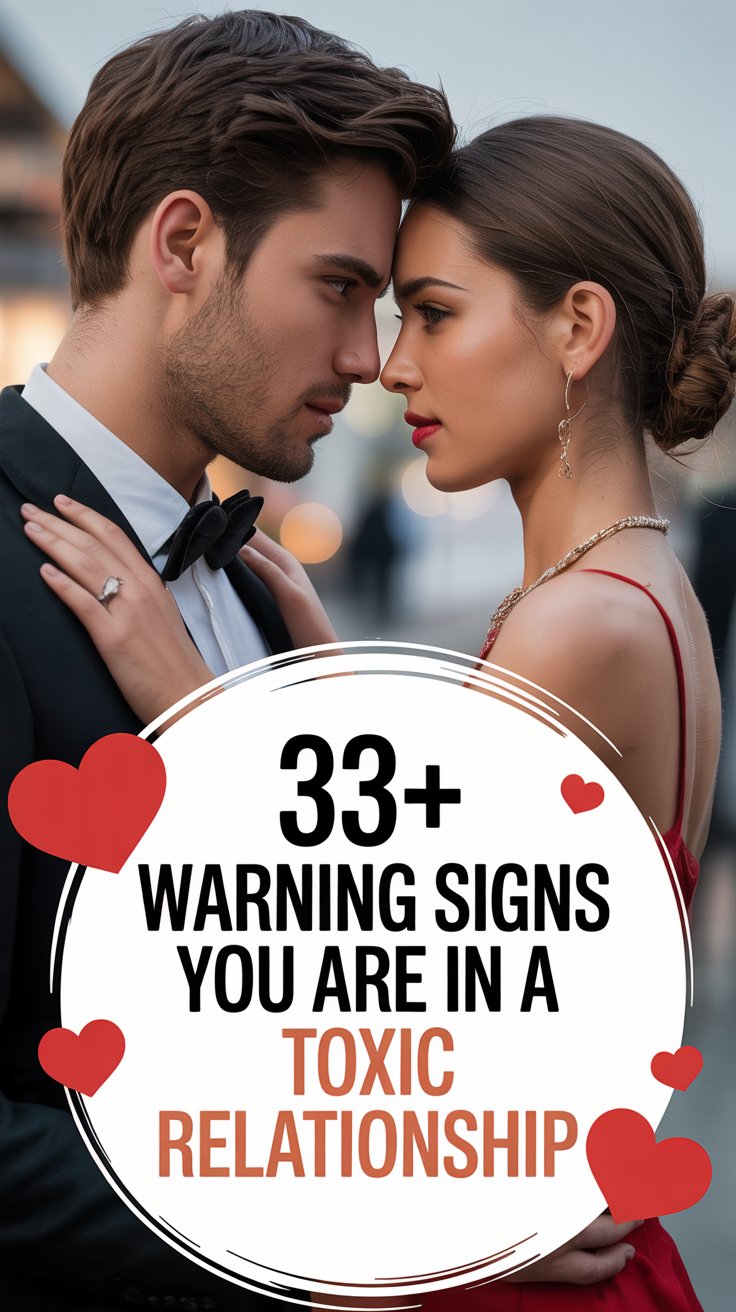A healthy relationship should make you feel safe, valued, and respected. But when a partnership is filled with negativity, manipulation, and constant tension, it can become toxic—silently damaging your mental and emotional well-being.
Toxic relationships aren’t always obvious. They often start with small, dismissive behaviors that escalate over time, leaving you doubting your self-worth. In this article, we reveal 33 warning signs of a toxic relationship, backed by psychology and relationship science, along with expert strategies to heal and move forward.
What Is a Toxic Relationship?
A toxic relationship is any connection—romantic, platonic, or even familial—where negative patterns outweigh positive ones. These patterns may include manipulation, control, disrespect, or emotional neglect.
Key traits of toxic dynamics include:
- Lack of mutual respect and support
- Emotional, verbal, or physical abuse
- Control, jealousy, and power imbalances
- Constant stress, anxiety, or fear of upsetting your partner
33 Warning Signs You’re in a Toxic Relationship
We’ve broken these signs into 4 categories for clarity: emotional, behavioral, power-related, and physical red flags.
1. Emotional and Psychological Red Flags (1–11)
- Constant Criticism – Your partner nitpicks your every move or belittles your accomplishments.
- Gaslighting – They make you question your reality or memories (“That never happened!”).
- Emotional Manipulation – Using guilt or shame to get their way.
- Controlling Behavior – Dictating your decisions, from what you wear to whom you meet.
- Isolation – Cutting you off from friends or family.
- Extreme Mood Swings – You never know what will trigger them.
- Boundary Violations – Ignoring your personal limits or needs.
- Silent Treatment – Withholding affection or communication to punish you.
- Dismissing Your Feelings – Labeling your emotions as “too sensitive” or “crazy.”
- Blaming You for Everything – Never accepting responsibility.
- Playing Victim – Twisting situations to make you feel guilty.
2. Behavioral and Communication Red Flags (12–22)

- Passive-Aggressive Behavior – Backhanded compliments or sarcastic digs.
- Verbal Abuse – Name-calling, yelling, or hurtful language.
- Threats and Ultimatums – “If you leave, I’ll ruin you.”
- Unresolved Conflicts – They refuse to talk through issues.
- Lack of Apologies – Even when they’re clearly wrong.
- Monitoring Your Activities – Checking your phone, social media, or whereabouts.
- Ignoring Your Needs – Your emotional or physical needs are never prioritized.
- Public Embarrassment – Making fun of you in front of others.
- Withholding Affection – Using love as a bargaining chip.
- Inconsistent Behavior – Hot-and-cold treatment, keeping you on edge.
- Overreacting to Minor Issues – Turning small arguments into major conflicts.
3. Power and Control Red Flags (23–28)
- Unbalanced Effort – You give 90%, they give 10%.
- Financial Control – Restricting your access to money.
- Making Decisions Without You – Ignoring your input on big matters.
- Threatening to Leave as Manipulation – Using fear to keep you compliant.
- Dishonesty – Habitual lying or keeping secrets.
- You Lose Your Identity – You no longer recognize yourself due to constant compromise.
4. Physical and Safety Red Flags (29–33)
- Physical Violence – Any form of hitting, shoving, or harm.
- Sexual Coercion – Pressuring or forcing intimacy without consent.
- Threats of Self-Harm – To control your actions.
- Sabotaging Your Success – Jealous of your progress and achievements.
- Chronic Anxiety and Stress – Your body reacts negatively when they’re around.
The Psychology Behind Toxic Relationships

- Trauma Bonding: When cycles of abuse are followed by periods of affection, you may develop a bond similar to addiction.
- Attachment Wounds: People with insecure attachment styles often stay in toxic dynamics longer.
- Control Mechanisms: Narcissistic or manipulative partners thrive on power imbalances.
Expert Insight: “Toxic relationships often begin with subtle disrespect. By the time it escalates, the victim’s self-esteem is too eroded to walk away,” says Dr. Aisha Qureshi, a relationship therapist.
How to Heal and Move Forward
- Acknowledge the Problem – Recognizing toxicity is the first step to change.
- Seek Professional Support – Therapy or counseling can help you process trauma.
- Set and Enforce Boundaries – Clearly communicate your limits.
- Build a Support System – Lean on trusted friends or family.
- Consider No-Contact – If the relationship is abusive, cutting ties may be necessary.
- Rediscover Yourself – Engage in hobbies, journaling, and activities that boost self-worth.
FAQ
1. Can a toxic relationship get better?
With therapy and both partners committed to change, improvement is possible. However, many toxic relationships worsen over time.
2. Can both partners be toxic?
Yes. Sometimes both partners contribute to an unhealthy dynamic, often due to unresolved trauma.
3. How do I leave a toxic relationship safely?
Create a safety plan, seek support, and consider professional help if the relationship involves abuse or threats.
Final Thoughts
Recognizing these 33 warning signs of a toxic relationship can save you from years of pain and confusion. No relationship is perfect, but a healthy one should uplift, not drain, you. You deserve respect, love, and emotional safety. If multiple signs resonate with you, consider seeking professional guidance to protect your mental health and build a brighter, healthier future.





